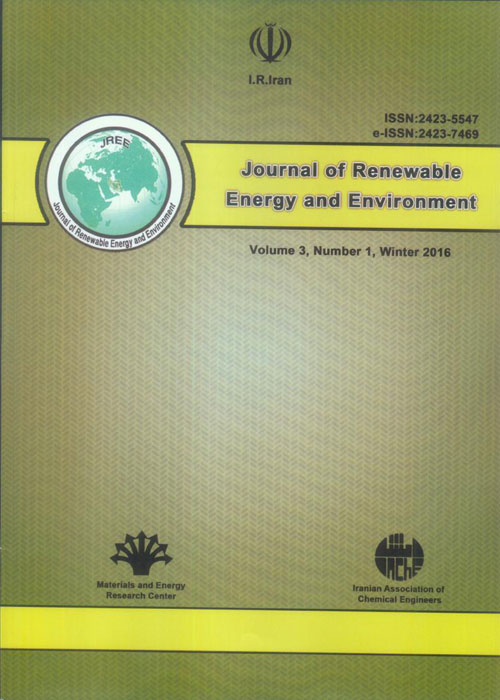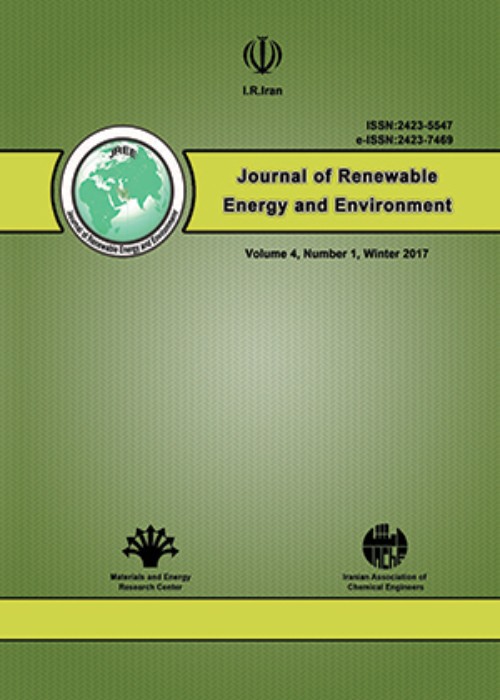فهرست مطالب

Journal of Renewable Energy and Environment
Volume:3 Issue: 1, Winter 2016
- تاریخ انتشار: 1395/01/29
- تعداد عناوین: 7
-
-
Page 1Energy obtained from renewable sources has increased its participation in the energy matrix worldwide, and it is expected to maintain this tendency. Both in large and small scales, there have been numerous developments and research with the aim of generating fuels and energy using different raw materials such as alternative crops, algae and waste cooking oil. Capparis spinosa seed (containing 32% triglycerides) is used as an excellent source for biodiesel production. In this work, biodiesel (Fatty acid methyl ester) is produced by trans-esterification of Capparis spinosa oil, in the presence of methanol and sodium hydroxide as an alkaline catalyst. According to data collection, pilot of biodiesel production is simulated by using HYSYS v3.2 software. The yield of biodiesel in the presence of sodium hydroxide was considered 94%. The results of FTIR and GC-MS spectra showed trans-esterification reaction has been complete. According to the results, the produced biodiesel is in the range of ASTM Standard.Keywords: Capparis spinosa, biodiesel, transesterification, pilot simulation
-
Page 8This paper deals with numerical study of semi-finite incompressible flow of air over two blocks with different heights in the presence of a condensing-source, dispensing- contaminant in the flow, in both steady and unsteady states. The numerical solution of governing PDE equations are constructed by a finite-volume method applied on structured grid arrangement. The effects of air flow velocity, contaminant source length and position, and the blocks height ratio on the concentration distribution, the mass transfer level and the time of transportation are studied. The results indicate that by increasing the inflow Reynolds number, the amount of contamination reaching the blocks and also the amount remaining between them decrease, while the mass transfer rate increases. It is shown that the closer the contaminant source to the blocks, the higher the mean concentration accumulating between the two blocks. It is also found that increasing the blocks'' height ratio makes an ascending trend to the time for the arrival of contaminant to the blocks'' walls, though the slopes of time-lines are different for each case.Keywords: Contaminant dispersion, Blocks, Unsteady flow, Numerical study
-
Page 17High costs, unreliable resources for long term use and extensive negative impact on our environment are such problems associated with traditional sources of energy and fossil fuels which make us move toward implementation of renewable sources of energy. Fossil fuel pollution and reserve depletion in oil producing countries caused by increasing demands, make wind energy an attractive source of energy in the future. Renewable energy sources are expected to have an important role in many countries as well as Iran and would be flourished in near future. In this study we aim to offer economic evaluation of wind turbine installation for chabahar in southeastern part of Iran. This study evaluates the economic feasibility of electricity generation using wind turbines in Chabahar - Iran situated in the Southeast part of Iran. All analyzes were performed by Homer software and local weather information and software provided by NASA Weather Homer is used. In this study 5 MW wind turbine with INVELOX technology is used .The analysis results show that Annual average of wind speed is 4.11 m/s at a Height of 10 m and 905 Gwh is the average of annual energy production, the cost of energy is calculated of 2.3 cents/kwh.Keywords: Wind power potential, Iran, Capacity factor, chabahar, Sistan, Baluchestan
-
Page 25This paper presents sizing, energy management strategy, and cost analysis for a configuration consisting of solar photovoltaic (PV) panels, fuel cell (FC) storage system, and reverse osmosis (RO) desalination technology for combined power and fresh water production. In this system, PV is the main power supply source; fuel cell is a storage system accompanied by Hydrogen production and storage devices; and for fresh water production, RO technology is considered as desalination unit. Energy production strategy, developed on the basis of solar irradiance, hourly electricity consumption, and daily fresh water demand to minimize the capacity of components. To this goal, a flowchart diagram is designed, and sizing method is modeled using MATLAB software based on this flowchart. Finally, economic analysis for co-production of fresh water and electricity is discussed, and results of sensitivity analysis for variations of net present value (NPV) cost in terms of different fuel cell storage system prices and different interest rates are presented. Results show that described energy management strategy causes the configuration to follow hourly electrical demand and daily fresh water requirement precisely, so that the total surplus energy production during a day is very little and negligible. Moreover, calculations show that the largest part of costs is due to the energy storage system. So, while the solar PV is the main energy source and solar irradiance in Khark Island more than Astara, the overall configuration cost is greater in Khark Island just because of greater energy storage system costs, nevertheless, using such energy storage systems is necessary due to intermittent inherent of solar energy.Keywords: renewable energy, solar photovoltaic, fuel cell, reverse osmosis, desalination
-
Page 35Maximum Power Point (MPP) tracker has an important role in the performance of fuel cell (FC) systems improvement. Tow parameters which have effect on the Fuel cell output power are temperature and membrane water. So contents make the MPP change by with variations in each parameter. In this paper, a new maximum power point tracking (MPPT) method for Proton Exchange Membrane (PEM) fuel cell is proposed. This method is based on water cycle algorithm (WCA). In order to show the performance and the accuracy of the proposed method, a system consisting of one Proton Exchange Membrane (PEM) fuel cell, one boost converter, one WCA based MPP tracker and one load is considered. WCA determines voltage corresponding to the maximum power of FC then one PID controller tunes the duty cycle of the boost converter. The performance of the proposed method is compared with three other MPPT methods (Perturb and Observe, Voltage-based MPPT and current-based MPPT). The results show that the proposed MPPT method has a high accuracy and a fast response, they also indicate that the proposed method has the better performance in comparison with the other studied methods.Keywords: Proton Exchange Membrane Fuel Cell Maximum Power Point Tracking (MPPT), Water Cycle Algorithm, Perturb, Observe, Voltage based MPPT, Current based MPPT
-
Page 43This paper deals with a multi-objective optimization of a novel micro solar driven combined power and ejector refrigeration system (CPER). The system combines an organic Rankine cycle (ORC) with an ejector refrigeration cycle to generate electricity and cold capacity simultaneously. Major thermodynamic parameters, namely turbine inlet temperature, turbine inlet pressure, turbine back pressure, and evaporator temperature are selected as the decision variables. Three objective functions, namely the energetic efficiency, exergetic efficiency and cost rate of products are selected for optimization. NSGA-II and MOPSO are employed and compared, to achieve the final solutions in the multi-objective optimization of the system operating. It is found that the values of the energetic and exergetic efficiencies increase within 27.7% and 26.1%, respectively and the cost rate of products decreases by about 32.7% with respect to base case.Keywords: Solar Energy, Cogeneration, Multi, Objective Optimization, NSGA, II, MOPSO
-
Page 52Renewable energy sources are developed worldwide, owing to high oil prices and in order to limit greenhouse gas emissions. The objective of this research was to study the feasibility of biodiesel production from mountain almond (Prunus Scoparia) oil using ultrasonic system and optimization of the process using Artificial Bees Colony (ABC) Algorithm. The results showed that by increasing the molar ratio, the conversion percentage increased and after reaching a certain ratio, further increase in the molar ratio caused decrease in the conversion percentage. Increasing in the ultrasound amplitude resulted in an increase in the conversion percentage which tends to ascend; Furthermore, results of optimization showed that the amount of molar ratio, amplitude, pulse and reaction time were 5.6, 0.90, 0.33 and 5 min, respectively. For independent variables, the values of yield and energy consumption were obtained which were equal to 96.1% and 9912 J, respectively. This finding proves that ABC algorithm can estimate the optimum point in biodiesel production with high accuracy.Keywords: Mountain Almond, Biodiesel, Artificial Bees Colony, RSM, Ultrasonic


